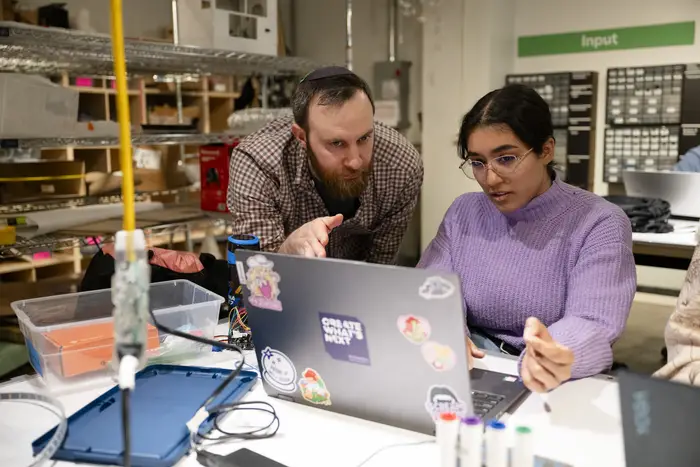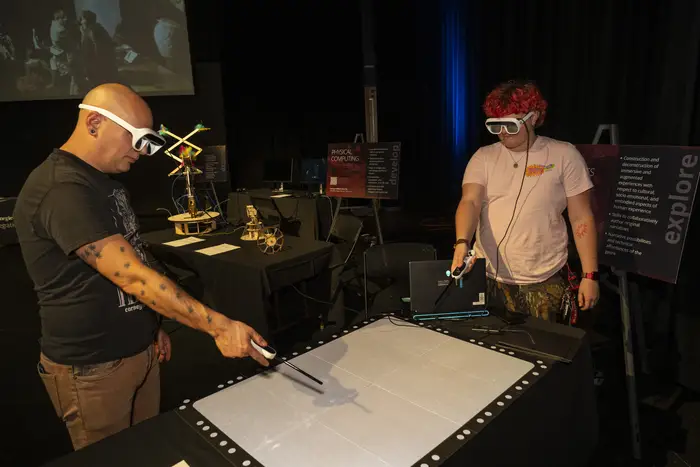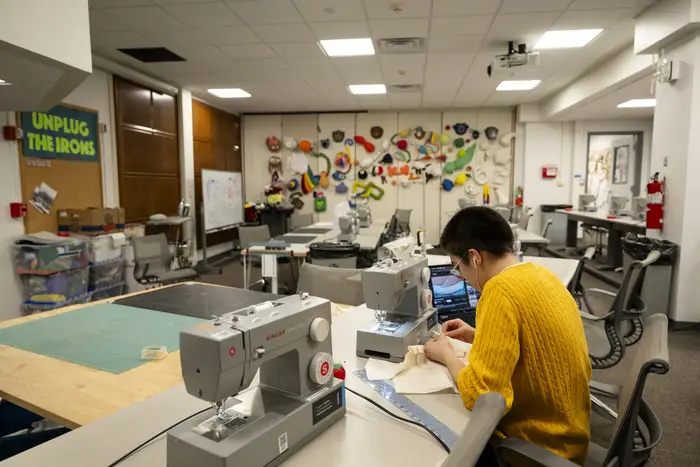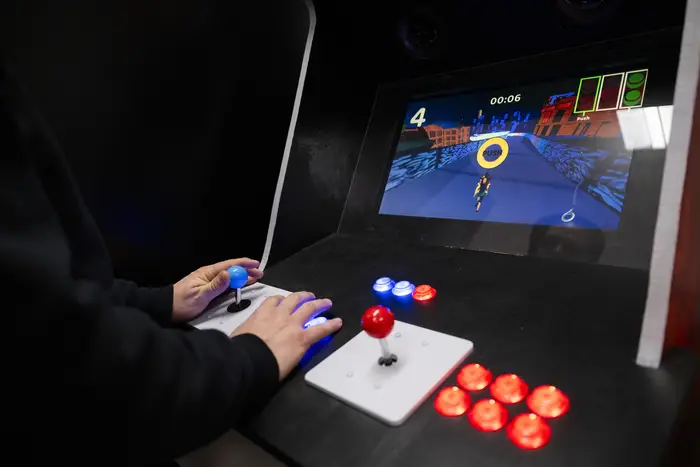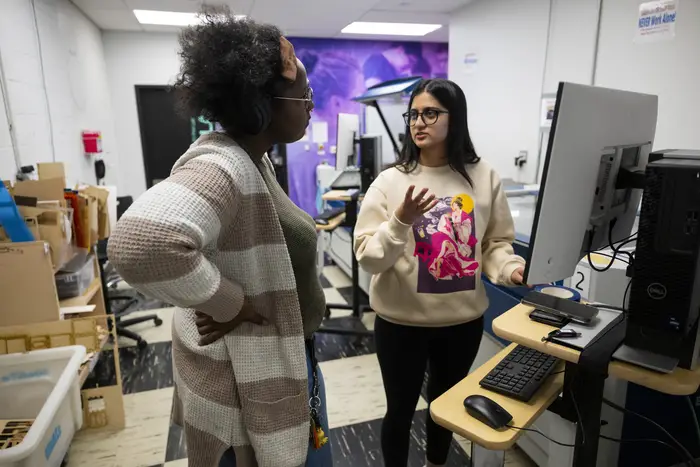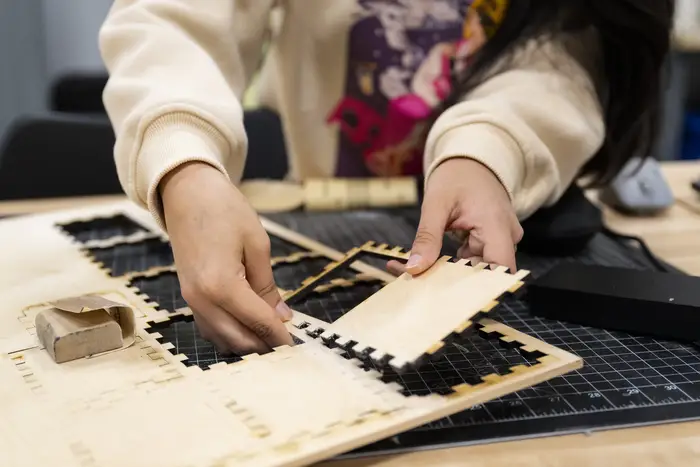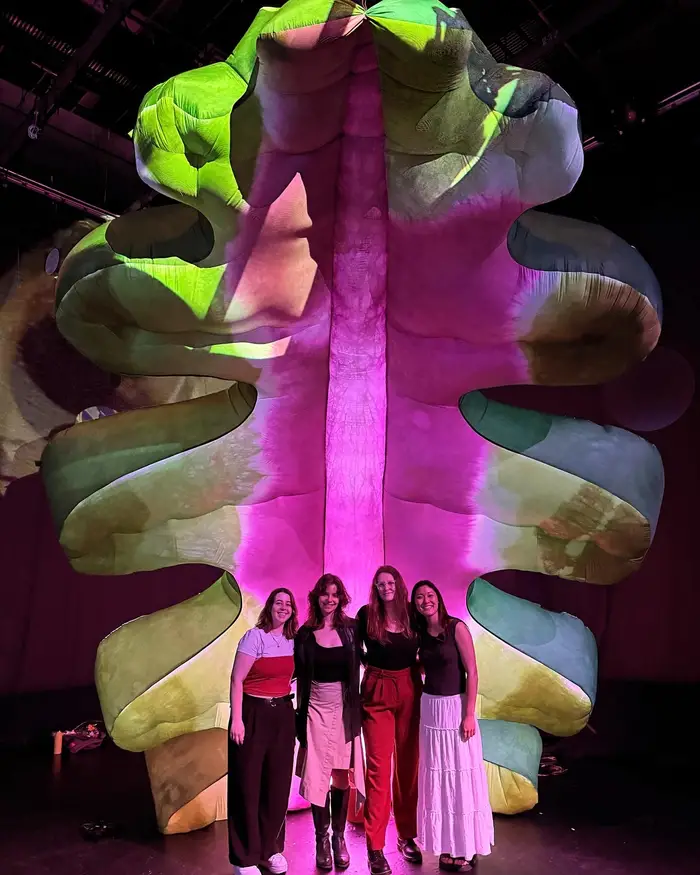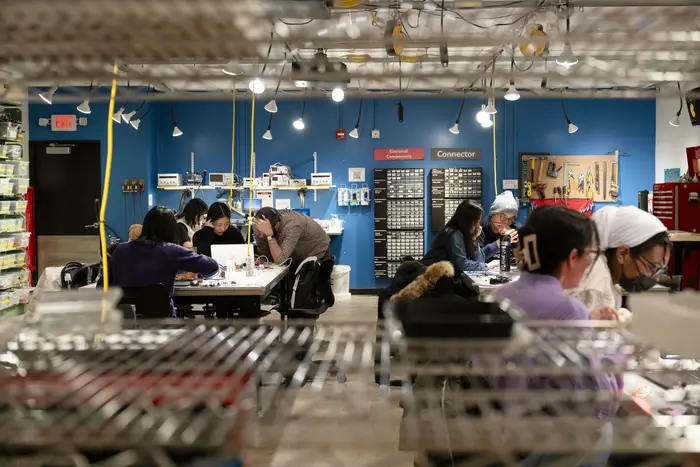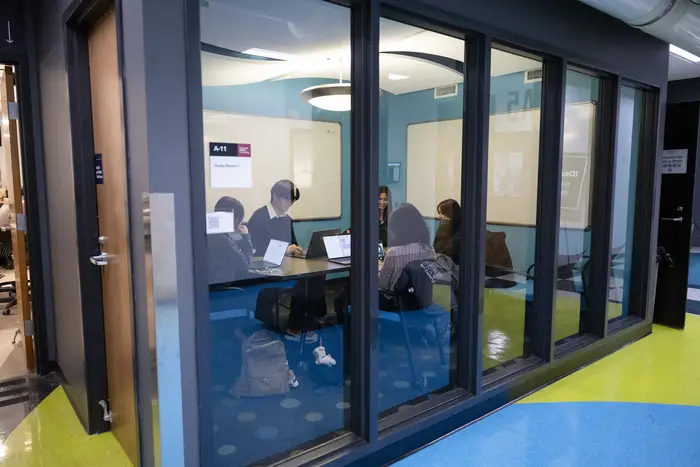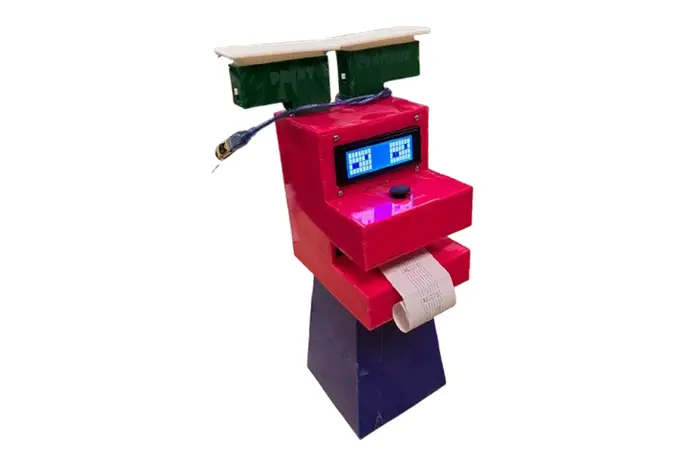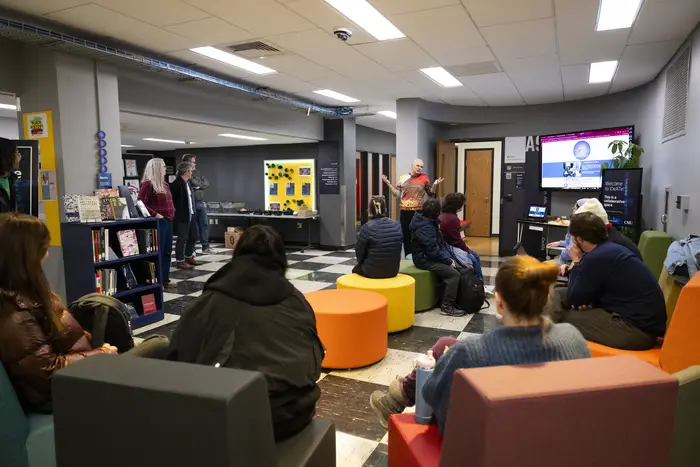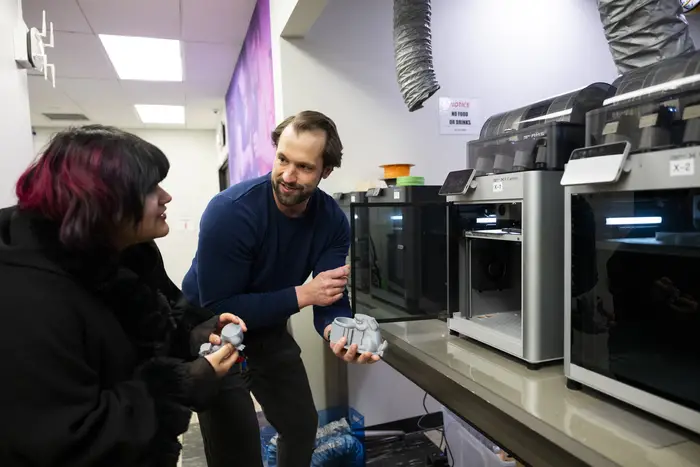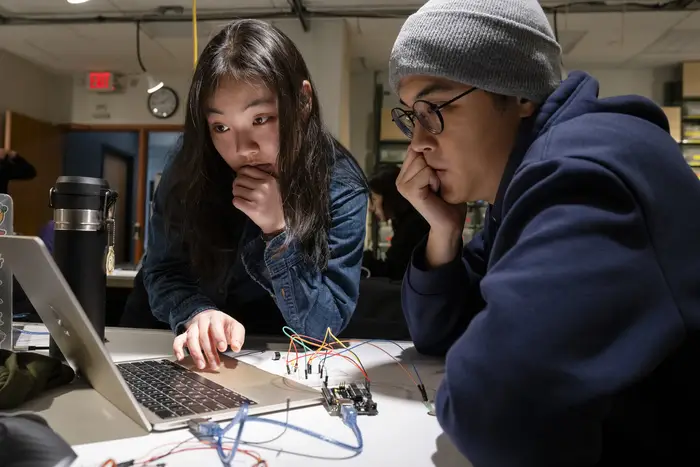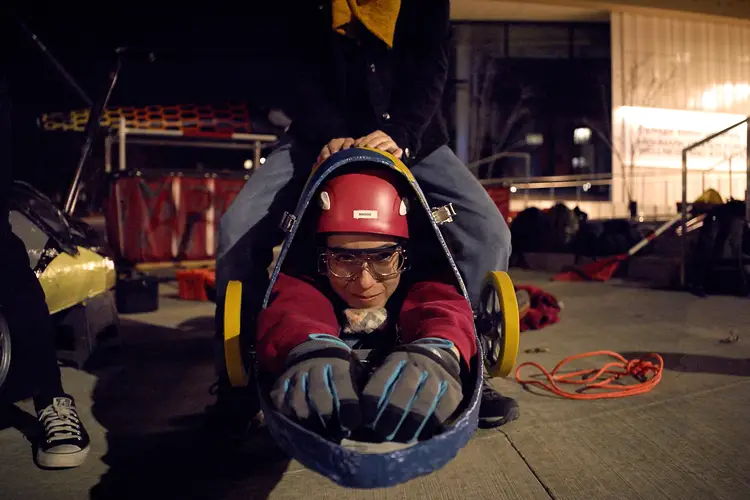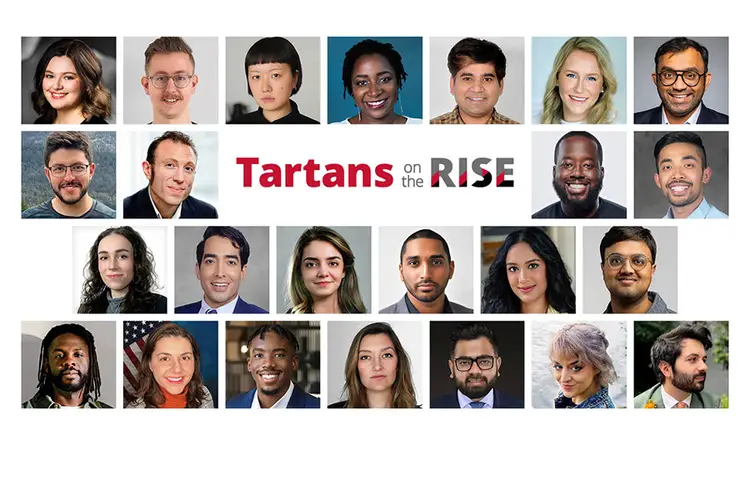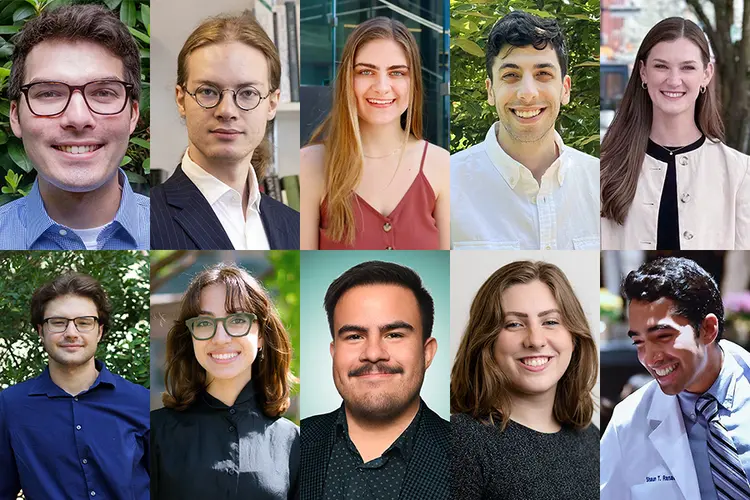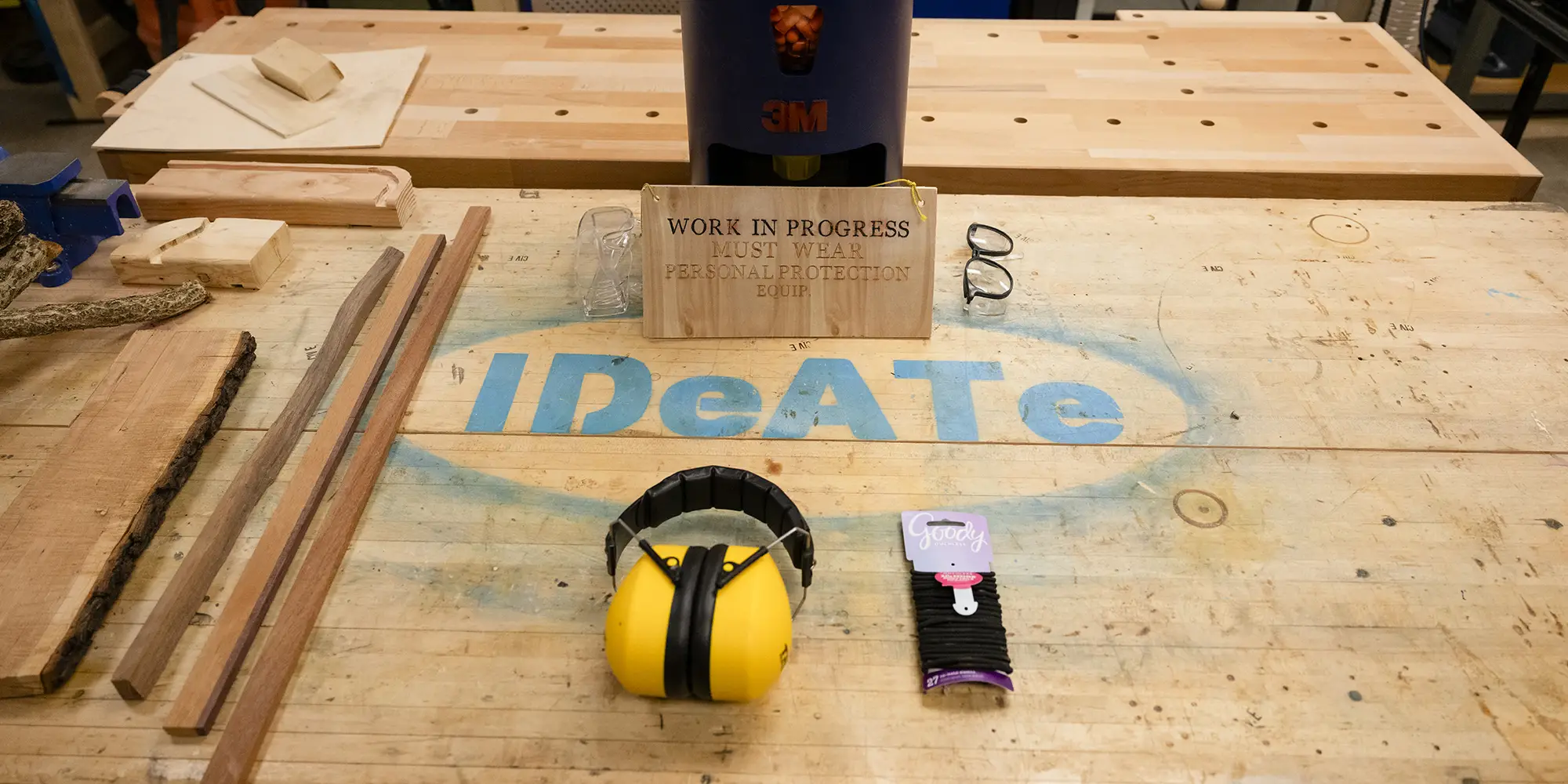
IDeATe at 10: Celebrating a Decade of Collaborative Innovations
Media Inquiries
The most valuable treasures are often buried. So, it should come as no surprise that IDeATe(opens in new window) (Integrative Design, Arts and Technology), a wildly sought-after interdisciplinary program for students at Carnegie Mellon University, is hidden in the basement of Hunt Library.
Instead of a treasure map, a peculiar lighting installation in the library’s stairwell leads visitors to IDeATe’s whimsical and funky underground haven — a maker’s paradise consisting of collaborative classrooms(opens in new window), a lending office(opens in new window), fabrication(opens in new window) and physical computing(opens in new window) labs, and a black box studio(opens in new window).
Aptly named "Ideation(opens in new window)," this standout project from IDeATe's first decade is responsive to ambient sound, such as footsteps, voices, doors closing and the elevator, while offering a variety of interactions when people clap, play music or whistle. It was designed in 2015 by Jaime Chu and Robert Rudolph, two of the program's initial enrollees.
“The light installation has gone through a few iterations in the last 10 years,” said Kelly Delaney, assistant dean and the program’s primary contact since its inception, “but it still captures the essence of what the students wanted, which was to draw people’s attention to the basement where all these cool ideas and projects are taking shape.”
IDeATe Open Labs and Studios
Friday, April 4, 2025
12 - 3 p.m.
IDeATe Studio A, Hunt Library
Want to learn more about soft technologies, physical computing, sonic arts or game design on campus? Want to playtest some new video games or step inside a virtual reality experience? Make a creative Carnival stop at the IDeATe Open Labs and Studios in Hunt Library to learn more about interdisciplinary student projects and unique immersive course events. Registration is requested through the CMU Carnival website(opens in new window).
Meet Me @
IDeATe Spring 2025 Exhibition
Apr 30, 2025
10 a.m. - 4 p.m.
Studio Theater, Cohon University Center
Meet Me @ is a semesterly exhibition of the innovative projects and research developed at IDeATe. Experience an engaging afternoon at the creative intersection of art and technology featuring game play, a mending workshop, animations, textiles and more.
How may I connect you?
Delaney has long referred to herself as the IDeATe 'switchboard,' seamlessly connecting a complex network of students and faculty, and generally ensuring the program's smooth operation.
“Initial enrollment for the first batch of IDeATe courses was around 300, and 150 students had declared IDeATe minors. Over the years, the curriculum has grown, and we now typically see enrollment totaling around 1,200 students over the academic year, with 250-300 students declaring minors,” she said.
Delaney joined the program as its first staff member when IDeATe was still just “an idea.” Since then, she has been a pivotal figure in the program's development and growth, helping to shape IDeATe into the vibrant and supportive community it is today.
“Having been at Carnegie Mellon for about eight years before I joined IDeATe, I was able to bring to the table some knowledge of how the gears worked at the university and at the same time explore new ways of working with departments," she said.
Now, anytime somebody has an idea for a new IDeATe course or project, Delaney is one of the first people they reach out to, although she said her role also involves sitting in the background, observing what's going on and discerning whether or not she needs to intervene.
"It’s always been about striking a balance. You don't want to impose too many limits on students and faculty in terms of what they might want to explore idea-wise,” she said. “Sometimes the ideas are a little too out there, and we have to say, 'Well, we can't do that, but we could do something like this.’ The expertise is in making student-faculty collaborations happen in a way that truly reflects the university's values."
Whole lotta makin’ going on
Launched in 2015, the IDeATe program was designed to bridge the gap between technology and the arts, offering students a unique opportunity to explore the intersections of these fields. Over the past decade, IDeATe has grown to include a diverse array of minors and courses, ranging from game design and animation to sonic arts and intelligent environments.
Olivia Robinson, a teaching professor at CMU’s Entertainment Technology Center(opens in new window), has witnessed the significant growth of the IDeATe programs and studios since she joined IDeATe in 2019 to found the soft technologies minor.
“We’ve gone from eight sewing machines in a cabinet to now having a dedicated sewing lab with 20 machines and computerized embroidery machines, as well as a dedicated dye lab,” she said. “The growth of the program has been exponential. It’s a reflection of student interest.”
Among her faculty collaborations are a popular dye class(opens in new window) she co-teaches with chemistry professor Gloria Silva and a course taught by Melisa Orta Martinez(opens in new window), an assistant professor in the Robotics Institute(opens in new window), that uses textile weaving and building robotic looms to teach advanced math.
“I feel incredibly fortunate in the collaborations with other faculty and departments. This is due to the creative and curious faculty that Carnegie Mellon recruits,” Robinson said.
Robinson teaches an inflatables class that gives students with no prior sewing or sculptural experience the opportunity to create large inflatable forms. The projects involve multidisciplinary teams and collaboration with sound and animation classes. The class had a significant impact on Maddie Burroughs, a senior in electrical and computer engineering(opens in new window) (ECE) who is pursuing minors in soft technologies and media design through IDeATe.
“I was able to develop strong sewing skills, which isn't something I had done before,” Burroughs said. “For the final project, I was partnered with three other students, all in different colleges studying very different things. Working with our team gave me the opportunity to collaborate with others, applying my background to compliment theirs in a way I'm not able to do in my home department. In the end, we made a literally larger-than-life nature-themed inflatable that was showcased at WQED.”
Burroughs said through the IDeATe program she’s been able to apply her primary major in more creative ways that interest her.
“Many of the instructors are artists and makers themselves, and the instructors I've been able to work with in IDeATe are some of the most invested and compassionate instructors I've ever worked with,” she said. “Our projects and assignments are often more flexible or self-defined than in other departments. The instructors really want to help you personalize project ideas based on what you're interested in or want to learn.”
Robinson said some students choose their career paths based on their experiences in IDeATe.
“Sarika Bajaj(opens in new window) was originally an ECE major. She started a company called Refiberd(opens in new window) focusing on recycling used textiles after her experiences in IDeATe,” Robinson said.
Zarmond Goodman, a film and visual media studies major, works in the fabrication lab as a senior tech adviser helping students safely operate the laser cutter. Having switched majors twice, Goodman is grateful to have had IDeATe as “an anchor,” “a common thread” and “a safe space” to stay grounded.
“I hope the next 10 years bring more visibility to IDeATe,” Goodman said. “The IDeATe community offers a real sense of belonging no matter what your background or experiences are.”
One memorable project Goodman recalled supervising was a scaled map of Pittsburgh with color-coded features, such as roads or bodies of water. Goodman helped the student translate the color codes to different laser strengths, so the laser would burn either darker or lighter. The map was also two scales, so they had to cut multiple pieces and put them together into one.
“It was really interesting to see the project physically exist in front of me after seeing it on the computer,” Goodman said. “That back-and-forth communication of trying to help someone who has a different skill set than you is also an invaluable skill to learn.”
Some of Goodman’s favorite projects to work on are the ones that students create in Robert Zacharias(opens in new window)’ physical computing class.
“Many of Robert's students come into the fabrication lab with the coolest projects aimed at making life easier for people with disabilities,” they said. “I always love helping with those projects. That class is offered every semester, so I always get to interact with them and hear their stories about how people are helping other people, which is great.”
Inspiring, empowering and uplifting
Since the spring of 2018, Zacharias has been teaching IDeATe’s Intro to Physical Computing course, which goes beyond technical learning, encouraging students to design and build assistive technology. He aims to create meaningful experiences for students by linking their skills to real-world needs. This approach not only helps them acquire valuable expertise but also fosters a deeper understanding of empathy and service, which he hopes will have a lasting impact on their future endeavors.
"We meet with people with disabilities, and I put the students in teams of three. At this point in the semester, they know how to do some technical stuff, but orienting them toward an act of service is a very different and more meaningful experience," Zacharias explained. "I hope students retain the experience of building something for somebody and really trying to understand that person's needs and preferences. It can inform the way they go on to do all sorts of things in the rest of their life."
One student team interviewed a woman named Allie, who uses a wheelchair and has various disabilities. Instead of focusing on a physical need, which was beyond their expertise and timeframe, they aimed to lift her spirits. Knowing she loves dogs, they built a dog-shaped device that prints positive messages(opens in new window) when petted on one ear, using a receipt printer on the dog's tongue.
"It was a different conception of an assistive device, which I really appreciated. It’s wonderful and sweet, and kind of funny, and it totally encapsulates what IDeATe means to me: meeting a need in a way you wouldn't typically think of," he said.
"There are lots of these kinds of projects,” Zacharias added. “I walk away from pretty much every final critique impressed, thinking, ‘Wow, that was pretty good.’"
Cheers to the next 10 years
Looking forward, IDeATe remains committed to nurturing the next generation of innovators. With a decade of success behind it, the future looks brighter than ever before for this unique and dynamic initiative. Even after 10 years, Delaney said, they continue to learn and recognize the need for growth, change and improvement.
"The potential for the program is immense. There’s an amount of care and tenderness that the people who come through here exude for the program, for people they work with and for the institution. It’s really special," she said. "Being in a space on campus where experimenting can happen in unique and funky ways, and the stakes aren’t too high or too low, we’re really proud of that, and I think that there is something so very Carnegie Mellon about it.”
Keith Webster(opens in new window), dean of University Libraries and director of Emerging and Integrative Media Initiatives, said the reality of the workforce students will enter after graduation is that they are going to be communicating and collaborating with people from different backgrounds.
“What we want our students to do is to learn how people from different disciplines solve problems, and we want them to begin to respect each other’s disciplines, to understand everybody is engaged in often similar ideas and concepts but they address them in different ways,” he said. “We’ve designed the courses and minors in IDeATe to be cross-disciplinary, where the students learn from each other, and where we integrate disciplines to better suit what we know industry is looking for and to prepare our students for jobs in a way that opens doors rather than closes them.
“Maker-centered learning helps our students develop a sense of self and a sense of community that gives them the confidence to engage with and shape different dimensions of the world they will enter as they leave Carnegie Mellon.”

